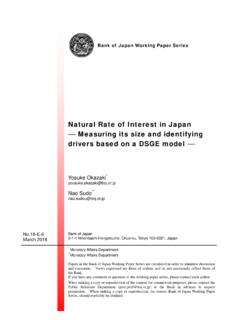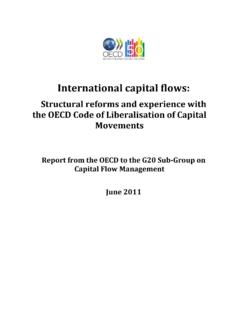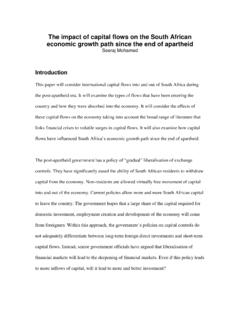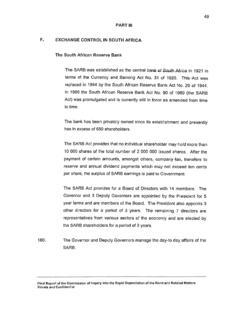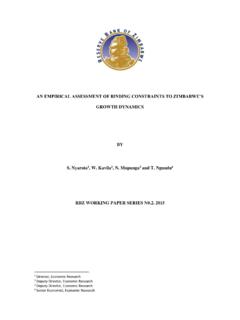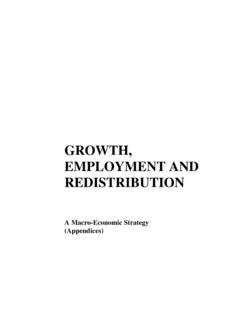Transcription of Global Stock Return Comovements: Trends and …
1 Global Stock Return Comovements: Trends and Determinants Kei-Ichiro INABA*. -E-7 Bank of Japan April 2018 2-1-1 Nihonbashi-Hongokucho, Chuo-ku, Tokyo 103-0021, Japan *. International Department, Bank of Japan. Papers in the Bank of Japan Working Paper Series are circulated in order to stimulate discussion and comments. Views expressed are those of authors and do not necessarily reflect those of the Bank. If you have any comment or question on the working paper series, please contact each author. When making a copy or reproduction of the content for commercial purposes, please contact the Public Relations Department at the Bank in advance to request permission. When making a copy or reproduction, the source, Bank of Japan Working Paper Series, should explicitly be credited. Global Stock Return Comovements: Trends and Determinants*. Kei-Ichiro INABA . April 9, 2018. Abstract This article analyses Global Stock Return comovements for 37 advanced and emerging countries over the period 1996 2015.
2 The article reports that the comovements were greater in advanced countries than in emerging ones, but increased more rapidly in emerging countries than in advanced ones. Such comovements had upward and downward Trends in 23. and 7 of the sample countries, respectively. The driving forces behind these comovements were country fixed effects and country-specific time-varying factors. These factors include the increasing openness of international trade and finance, business climate, and institutional opaqueness, all of which worked in line with an information-driven comovement theory. The time-varying factors also include indicators representing monetary policy and capital controls, supporting a policy implication of a Global financial cycle hypothesis: a monetary policy dilemma. JEL classification: F3; G1; O1. Keywords: Financial globalisation; International portfolio diversification; Stock market comovements; Information-driven comovements; Global financial cycle * The author is grateful to Francis E.
3 Warnock (University of Virginia), Hans Genberg (The SEACEN Centre), Takashi Fueno (SMBC Nikko capital Markets), Costas Lapavitsas (SOAS, University of London), Sophie Van Huellen (SOAS, University of London), Yosuke Jin (Organisation for Economic Co-Operation and Development), Satoshi Urasawa (Cabinet Office, Government of Japan), Masashi Saito (International Monetary Fund), participants at the 75th Meeting of the EMEAP Working Group on Financial Markets, those at the 12th SEACEN-BOJ SEACEN Expert Group (SEG) Seminar/Meeting on capital Flows, and Bank of Japan officials, including Tetsuya Hiroshima, Ryo Kato, Eiji Maeda, Ko Nakayama, Hideki Nonoguchi, Hiroto Uehara, and Yoichi Ueno, for their helpful comments on earlier drafts. The author greatly appreciates that Toshinao Yoshiba (Bank of Japan) perused a draft and made useful comments and editorial advices. The author is grateful to Kenrin Nishimura (Bank of Japan) for his research assistance on data-collection.
4 The views in the article are those of the author alone and do not reflect those of the Bank of Japan. Any possible errors in this article are the exclusive responsibility of the author. International Department, Bank of Japan. E-mail: 1. 1. Introduction In the midst of increasing globalisation, international trade and capital mobility are hallmarks of cross-country market integration, a view succinctly noted in one of the seminal studies in this field: It is generally believed that increased capital market integration should go hand-in-hand with increased cross-country correlation (Bekaert et al., 2009, p. 2591). Such international capital market comovement is a key topic in finance, as it has important implications for asset allocation, risk management, and international diversification . (Chuluun, 2017, p. 53). In particular, the study of international Stock market comovement has long been at the heart of finance, traditionally by investigating the mode and presence of a trend in its degree, and more recently by specifying its determinants.
5 Since the Global financial crisis in 2008, Global financial market comovement has attracted much interest also in international finance literature as some costs to the comovement due to monetary policy spillovers have become more discernible (Passari and Rey, 2015). One policy implication of a Global financial cycle hypothesis a monetary policy dilemma is drawing increased attention from both academics and policy makers. It puts the Mundellian trilemma into question by arguing that domestic short-term interest rates cannot influence domestic financial asset prices without controlling the country's capital account, regardless of its exchange rate regime. Can monetary authorities affect the degree of Global comovement (DGC) of national Stock returns, and if so how? This question is a primary motivation behind this article, because Stock prices are an important element of domestic financial stability. One lesson of the Global financial crisis appears to be that domestic financial instability and its negative effects on the real economy can have grave consequences.
6 In the Global financial cycle hypothesis, a Global financial cycle synchronises international capital movements and asset price changes across countries, and two factors Global investors' risk preference and Global uncertainty are regarded as important Global common factors (GCFs) which drive that cycle (Rey, 2013; Rey, 2016; Passari and Rey, 2015;. Coeurdacier et al., 2015). The two factors are affected by United States ( ) monetary policy (Rey, 2013; Passari and Rey, 2015) and are reflected well in the implied volatility of Stock prices, or the Chicago Board Option Exchange Volatility Index (VIX) (Bekaert et al., 2013). monetary policy and VIX are determinants of gross capital inflows to individual countries (IMF, 2016; Hoggarth et al., 2016) as well as determinants of sudden 2. large-scale changes in international capital movements in those countries (Forbes and Warnock, 2012). Bruno and Shin (2015; 2017), moreover, argue that increasing easiness of dollar debt finance for internationally-active companies helps the Global financial cycle relax domestic financial conditions by activating domestic risk-taking and credit channels.
7 The dominance of some GCFs would be reasonable in a Stock market of imperfect and asymmetric information. In such a market, information is a non-rival good, high fixed costs are necessary to gather and process new information, and it is very cheap or free to replicate information that has already become available. According to Veldkamp's (2005; 2006). information-driven comovement theory, the lower price and greater popularity of a particular piece of information encourages investors to purchase it because they expect other investors to buy it too. As the number of investors gaining information on a specific Stock increases, Stock comovements increase; in the extreme case of full comovement, one piece of information on a specific Stock is used to infer the values of all other stocks. Supposing here a Global Stock market of that kind of imperfect information, in which (i) 37. stocks are traded, (ii) the issuers' names are those of my sample countries, and (iii).
8 Information costs to be paid by investors differ from country to country. Based on the information-driven comovement theory, two types of information can be produced there. One is low-cost soft information: information helping investors to infer a number of countries'. fundamental values. This information is the source of Global Stock Return comovements. GCFs can fall into this category of information. Globalisation helps low-cost soft information cover more countries' stocks by enhancing the interdependences amongst different countries'. fundamentals. This means that globalisation advances in tandem with increases in those countries' DGCs. There has recently been empirical confirmation of this relationship. The increasing responsiveness of European national Stock prices to Stock prices would be the result of financial integration (Baele and Soriano, 2010). National DGCs are positively associated with both trade liberalisation and financial liberalisation (Beine and Candelon, 2011).
9 1 Chuluun (2017) has supported the positive association between the level of national DGCs and the progress of international trade and finance by conducting an extensive network 1. In their case, a national DGC is a country's pairwise Stock - Return correlations adjusted for the boosting effect of high volatility. 3. analysis of 49 countries over the period 2001 2014. 2 These studies suggest that, with continued globalisation, national DGCs should have tended to increase over time. The other category of information produced is high-cost hard information: information enabling investors to learn a specific country's fundamental value. More of this type of information is produced as doing so is more profitable. This profitability depends on two factors. The first is good prospects for an investment asset's value because information has increasing-returns in an asset's value. What this means in the hypothetical Global Stock market is that when investors believe that a particular country has better economic prospects, they are more willing to gather the expensive hard information, implying a smaller national DGC for that country.
10 The second factor is the level of fixed costs necessary to produce information on a specific country. What this means in the Global Stock market is that a reduction in the costs stimulates investors' demand for hard information on the country, resulting in a smaller national DGC for that country. The necessary fixed costs can be reduced by advances in information technology and by a reduction in institutional opaqueness in individual countries. One example of the latter is a country fixed effect: the nature of the country's legal system. Institutional factors helping reduce information costs may be more effective in common-law countries than in civil-law ones. Such factors include respect for private property (Levine, 1997), 3 the level of disclosure (Jaggi and Low, 2000), and the quality of accounting information (Ball et al, 2000). Thus, if information costs continue to decline, national DGCs will tend to decrease over time. By analysing the presence and mode of Trends in national DGCs, this article contributes towards the literature on financial globalisation in general and towards empirical finance research on Stock market integration in particular.







